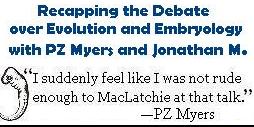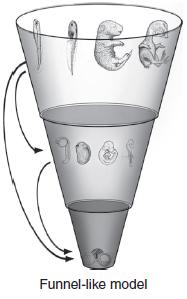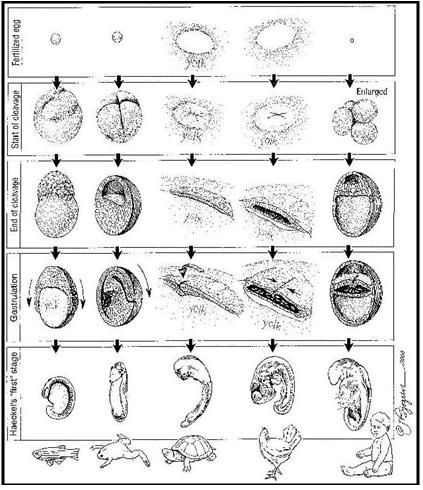 Evolution
Evolution
 Life Sciences
Life Sciences
Three Flawed Evolutionary Models of Embryological Development and One Correct One
table style=”margin: 0 0 10px 10px” border=”2″ cellpadding=”5″ align=”right”>

This series began when ENV writer Jonathan M. asked some tough questions of PZ Myers about evolution and embryology at a Skeptics event in Glasgow, Scotland. As a recap of this series, below are links to ENV articles which have appeared on this topic:
• Part 1: Colliding With the Pharyngula: My Encounter With PZ Myers: Jonathan M. gives his firsthand account of what happened at PZ Myers’ lecture.
• Part 2: Rate My Professors: P.Z. Myers: David Klinghoffer asks whether PZ Myers should be bullying undergraduate student Jonathan M. simply for asking some hard questions of evolutionary biology.
• Part 3: Revisiting Those Early Developmental Stages: A Response to PZ Myers: Jonathan M. responds to PZ, reiterating that he isn’t simply critiquing Haeckelian capitulation, and re-explains why the evolutionary funnel model of vertebrate development is wrong.
• Part 4: How P.Z. Myers’ “Incendiary Rhetoric” and “Class-War Claptrap” Shocks His Fellow Evolutionists (Prelude to a Rebuttal): Casey Luskin investigates PZ Myers’ heavy use of personal attacks, and why they expose PZ’s lack of scientific rebuttals.
• Part 5: Demystifying the Debate with PZ Myers Over Evolution and Embryology: Luskin breaks down the embryology debate between Jonathan M. and PZ Myers into three simple points and counterpoints, revealing that PZ is not responding to our arguments.
• Part 6: Haeckelian Recapitulation Is Not the Issue: Luskin explains, for the Nth time, that PZ Myers is wrong to consistently misrepresent ID arguments as only attacking Haeckel’s recapitulation model.
• Part 7: Caught in Contradictions, PZ Myers Claims “Evolutionary Theory Predicts Differences as well as Similarities” (and Therefore Predicts Nothing): Luskin discusses three contradictions in PZ’s arguments, showing PZ has changed his tune over what evolution says about vertebrate embryos.
• Part 8: PZ Myers Replies With Incendiary Rhetoric Instead of Scientific Arguments: After PZ writes a name-calling filled reply, Luskin explains that PZ uses personal attacks instead of scientific rebuttals.
• Part 9: Challenging the Precious Pharyngula: Luskin discusses mainstream scientific papers which challenge the existence of the idea which gives PZ’s blog its name–the “pharyngula”.
• This Article (Part 10): Three Flawed Evolutionary Models of Embryological Development and One Correct One: Luskin recounts various models of embryological development which have been discussed during this debate, concluding that evolutionary biology has failed to explain the data.
Throughout this series on PZ Myers, evolution, and embryology, we have discussed four models of vertebrate embryo development. To help further simplify this debate, these four models are illustrated below and described. Please note that the first three models are flawed in varying degrees, and that some of the descriptions adapt language from the arguments of PZ Myers and various scientific papers.
Model 1 — Haeckelian Recapitulation: Totally Flawed

Discussion: According to this model of embryogenesis, evolution predicts that development will conserve the evolutionary history of an organism, which is replayed as an organism develops. As Haeckel’s famous dictum said, ontogeny (development) recapitulates (replays) phylogeny (evolutionary history). This model is now essentially universally discarded by evolutionary biologists. Although Haeckelian recapitulation was abandoned long ago, many people have been taught it was true over the years. ID proponents recognize this fact, which is why we point out its falsity. However, we have a lot more to say than merely critiquing Model 1.
Unfortunately, PZ Myers typically misrepresents our arguments as if we’re only and always attacking Model 1, when in fact we’re usually attacking Models 2 and/or 3. Our main gripe with the usage of Haeckel’s ideas in the modern era is not that they are used to bolster Model 1 (after all, Model 1 is rarely promoted these days), but rather that Haeckel’s inaccurate drawings, which overstate the similarities between embryos, are still used to bolster Models 2 and/or 3. In any case, Model 1 is simply wrong because vertebrate embryos do not replay their supposed evolutionary history during development. The notion that ‘ontogeny recapitulates phylogeny’ is wrong.
Model 2 — Funnel-Like Model: Highly Flawed
 (From Naoki Irie & Shigeru Kuratani, “Comparative transcriptome analysis reveals vertebrate phylotypic period during organogenesis,” Nature Communications, Vol. 2:248 (2011).)
(From Naoki Irie & Shigeru Kuratani, “Comparative transcriptome analysis reveals vertebrate phylotypic period during organogenesis,” Nature Communications, Vol. 2:248 (2011).)
Discussion: According to this model, embryos start off developing similarly but become progressively different as time goes on. The evolutionary justification often given for this model is that precise developmental processes of the earliest stages of development are critical for later stages, and thus resistant to modification by mutation and selection. Evolution thus proceeds by modifying later stages of development since earlier stages which are more resistant to change. Under this model, evolution predicts that early development will be conserved (i.e. similar), and embryos will progressively diverge from one-another as development proceeds. This model is not supported by the data since early stages of vertebrate embryo development can vary widely.
Ideas inherent in this model are still found in many textbooks, which cite early similarities among vertebrate embryos as evidence of conserved stages of development which purportedly reflect their common ancestry. This model is inaccurate because early stages of development can vary greatly and show wide variation. PZ Myers also recognizes this fact. This means that he tacitly admits that a lot of textbooks are wrong.
Model 3 — Hourglass Model: Flawed
(From Michael K. Richardson et al., “There is no highly conserved embryonic stage in the vertebrates: implications for current theories of evolution and development,” Anatomy and Embryology, Vol. 196:91-106 (1997).)
Discussion: Under this model, vertebrate embryos start off developing differently, but then converge at the phylotypic or pharyngular stage, showing substantial conserved similarities to one another that are said to provide evidence of common descent. According to this model, the specific morphology of the phylotype represents a literal foundation upon which the rest of development proceeds, and is resistant to evolutionary change, because there are too many later events that are dependent on it.
This is the model preferred by PZ Myers and many other leading evolutionary biologists, and it is also commonly promoted in textbooks. This model recognizes that early and late stages–and to a significant extent middle stages–of development can vary greatly and show wide variation. However, it claims that vertebrates go through a highly similar stage – the pharyngular, phylotypic, or tailbud stage – midway through development. This pharyngular stage is said to reflect important developmental patterns which have been resistant to evolutionary change (“conserved”), and thus the pharyngular stage is said to reflect their common evolutionary heritage.
But in the past 15 years or so, a number of leading evolutionary biologists have recognized that the phylotypic stage is simply “assumed to be particularly resistant to the action of natural selection” and “often discussed in terms that emphasise conserved features, and ignore variable features.” When biologists carefully compare embryological data, they find that there is considerable variability at the purported phylotypic stage, leading increasing numbers of biologists to question whether this pharyngular stage exists. As a paper in Nature said last year: “both the model and the concept of the phylotypic period remain controversial subjects in the literature.” PZ generally refuses to address this literature, but it nonetheless calls into question the very concept that defines this model and gives PZ’s Pharyngula blog its name.
Model 4 — Reality: Correct

(From Jonathan Wells, Icons of Evolution (Regnery, 2000), Image Copyright Jody F. Sjogren 2000.)
Discussion This model simply lets the data speak for itself and does not try to force-fit some evolutionary interpretation to the data. This model acknowledges that there is wide variation in embryos at fertilization. Variation can and does occur between vertebrate embryos at every stage of development, and early and late stages — and to a significant extent middle stages — can and do vary greatly. Vertebrate embryos show some similarities — but also many significant differences — during the purported phylotypic stage. However, differences in body size, body plan, growth patterns, and growth timing show wide variation in morphology among vertebrate embryos which is difficult to reconcile with the idea of a phylogenetically-conserved stage. At best, there is a period of development where some general similarities emerge, but this looks very different than what is taught in most textbooks. These differences lead top embryologists to argue against the existence of a phylotypic stage in vertebrates. There is not a consistent pattern that is amenable to an easy evolutionary interpretation.
While there are some general hourglass-like patterns in vertebrate development, the pharyngular stage is called into question. Moreover, evolutionary biologists have struggled to explain how Darwinian processes could lead to hourglass-type patterns of development in the first place. As a 2011 paper in Nature Communications states:
One unanswered question in this field is how pharyngular stages became conserved. … [H]ow did vertebrate embryos allow the early developmental stages to diverge while keeping the following stage essentially unchanged? For example, in spite of considerable phylogenetic divergence in the mechanisms of vertebrate germ layer formation and gastrulation among the four species we analysed, all these embryos pass through the conserved pharyngula stage.
(Naoki Irie & Shigeru Kuratani, “Comparative transcriptome analysis reveals vertebrate phylotypic period during organogenesis,” Nature Communications, Vol. 2:248 (2011).)
As noted previously, from an evolutionary vantage, the evolution of vertebrate development almost appears goal-directed, where embryos if many taxa start off developing very differently but then converge on a somewhat similar stage midway. So how could Darwinian evolution preserve a midpoint of development as similar, when embryos start development so differently? The authors of this 2011 paper aren’t sure, and their article grasps for an evolutionary explanation that almost hints at a goal-directed evolutionary process:
For example, in spite of considerable phylogenetic divergence in the mechanisms of vertebrate germ layer formation and gastrulation among the four species we analysed, all these embryos pass through the conserved pharyngula stage. How did vertebrates establish divergence of early embryogenesis while keeping pharyngular stages conserved? One reasonable deduction from this observation is that early vertebrate embryogenesis reduces the developmental fluctuations, which tend to occur around these stages, much like earthquake-resistant buildings that are built with the ‘flexible structure’.
(Naoki Irie & Shigeru Kuratani, “Comparative transcriptome analysis reveals vertebrate phylotypic period during organogenesis,” Nature Communications, Vol. 2:248 (2011).)
So early stages of development are “built” to divergently evolve in a way that reduces changes to later stages of development? And we find this same pattern of development repeated throughout many different species of vertebrates? This almost sounds like a goal-directed and non-Darwinian form of evolution, which is precisely why early differences between vertebrate embryos were not predicted or anticipated by many evolutionary biologists.
Again, the Reality Model simply lets the data speak for itself and doesn’t try to force-fit some evolutionary pattern on to the data. While vertebrate embryos do show some similarities during the purported phylotypic stage, this model also reveals remarkable and significant differences at that supposed “stage.” This model thus recognizes that there is wide variability and remarkable divergence at all stages of development.
Whether an evolutionary pattern can be fit to the actual data remains to be seen. But when PZ Myers is forced to say: “I wish I could get that one thought into these guys heads: evolutionary theory predicts differences as well as similarities,” it seems clear that evolutionary biology is not predicting any model very well. If we just take the data at face value, the Reality Model is the most accurate model of vertebrate development.

